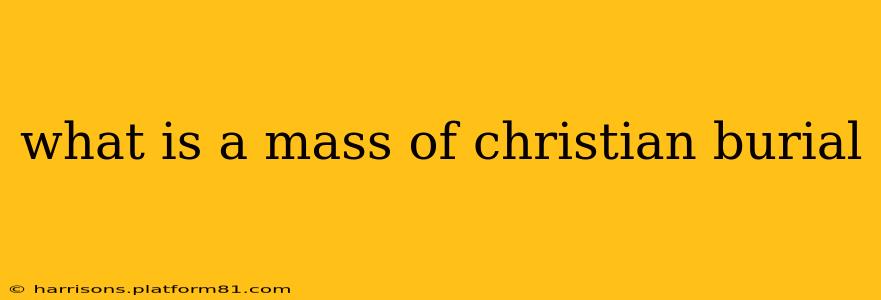A Mass of Christian Burial, also known as a Requiem Mass, is a Catholic funeral liturgy celebrating the life of a deceased person while entrusting their soul to God's mercy. It's a sacred ritual deeply rooted in Christian faith and tradition, offering comfort, hope, and a communal expression of grief and remembrance. Unlike simpler funeral services, the Mass of Christian Burial is a full liturgical celebration with specific prayers, readings, and rituals.
What are the key components of a Mass of Christian Burial?
The Mass of Christian Burial follows a structured order, typically including these key components:
-
The Entrance Procession: This begins with the arrival of the casket (or the urn containing the ashes), often accompanied by family and pallbearers. The procession symbolizes the entry of the deceased into the presence of God.
-
The Opening Rites: These include the greeting from the priest, the penitential rite (asking God's forgiveness), the Kyrie (a plea for mercy), and the Gloria (a hymn of praise, usually omitted during Lent and Advent).
-
The Liturgy of the Word: This section features readings from Scripture, often chosen to offer comfort and hope to the bereaved. The Gospel reading is particularly important, offering a message of salvation and resurrection. A homily (sermon) is usually given by the priest, reflecting on the life of the deceased and the promises of faith.
-
The Liturgy of the Eucharist: This is the central part of the Mass, where the bread and wine are consecrated and offered as a sacrifice for the living and the dead. The Eucharist is understood as a participation in the sacrifice of Christ and a communion of believers, both living and departed.
-
The Prayers of the Faithful: This involves intercessions offered by the congregation for various needs, including the deceased, their family, and the Church.
-
The Commendation and Farewell: This solemn part of the Mass entrusts the deceased soul to God's mercy and includes a final blessing. The priest prays for the soul's eternal rest and commends the body to the earth.
-
The Dismissal: The priest blesses the assembled mourners, offering words of comfort and hope. The recessional hymn and procession concludes the Mass.
What is the difference between a funeral Mass and a memorial Mass?
While both involve prayers for the deceased, there is a significant distinction:
-
Funeral Mass: A Funeral Mass is celebrated with the body of the deceased present. It's a central part of the Catholic funeral rite, incorporating the liturgical elements described above.
-
Memorial Mass: A Memorial Mass is celebrated without the body present. It's often held at a later date, offering a continued opportunity for prayer and remembrance. It maintains the liturgical structure of a Mass but might lack some elements specific to the presence of the body (such as the commendation).
Is the Mass of Christian Burial mandatory for Catholics?
While the Catholic Church strongly encourages a Mass of Christian Burial, it's not strictly mandatory. Other forms of funeral services are possible, depending on circumstances and individual preferences. However, the Mass is the most common and preferred way to celebrate the life and faith of a deceased Catholic.
What are some common prayers used during a Mass of Christian Burial?
Many prayers are specific to the Mass of Christian Burial, including the Eternal Rest prayer ("Eternal rest grant unto them, O Lord, and let perpetual light shine upon them."), prayers for the family, and the commendation prayers offered by the priest. The specific prayers may vary depending on the liturgical calendar and the preferences of the celebrant.
Can non-Catholics attend a Mass of Christian Burial?
Absolutely! Everyone is welcome to attend a Mass of Christian Burial. The service offers a powerful expression of faith, hope, and community, regardless of religious affiliation. While not participating in the Eucharist (unless also Catholic), attendees can still join in the prayers and reflections, offering support to the grieving family.
This explanation provides a comprehensive overview of the Mass of Christian Burial. The specific details and practices may vary slightly depending on the diocese and cultural context, but the core elements remain consistent with Catholic liturgical tradition.
